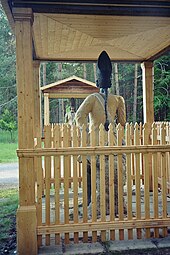Valdštejnsko
| Valdštejnsko | ||||
|---|---|---|---|---|
|
||||
| Basic data | ||||
| State : |
|
|||
| Region : | Středočeský kraj | |||
| District : | Mladá Boleslav | |||
| Municipality : | Bělá pod Bezdězem | |||
| Geographic location : | 50 ° 29 ' N , 14 ° 44' E | |||
| Height: | 320 m nm | |||
| Residents : | ||||
| Postal code : | 294 21 | |||
| License plate : | S. | |||
Valdštejnsko (German Waldsteinruhe , formerly Czech Valdštýn , also Valdštýnsko ) is a single layer belonging to the town of Bělá pod Bezdězem in the Czech Republic . It is located three kilometers west of Bělá pod Bezdězem at 320 m above sea level. M. in the middle of the Valdštejnský les ( Waldsteiner Forest ).
history
Waldsteinruhe originated in the first half of the 18th century when the landlord Franz Ernst von Waldstein had a circular clearing cut in the middle of the forest in order to build a group of hunting pavilions centered on a chapel. A round garden with a garden shed formed the focal point. In 1725 the complex, which formed the center of a star-shaped network of eight avenues, was completed.
In 1760, two oversized wooden grenadiers were set up on both sides at the entrance to the northwestern avenue as a reminder of the Waldstein grenadier company during the First Silesian War . In 1792, at the entrance to the northeast avenue, a statue of St. John of Nepomuk added under a stone canopy .
In 1832 Waldsteinruhe consisted of 19 houses with 52 Czech-speaking residents. The center of the village, located in the manorial zoo, was the manorial pleasure palace with several outbuildings; In addition, there was a forge, an inn, a hunter's house and the three Heger houses Mareschthor , Pankraz and Daniel . Waldsteinruhe partly belonged to the allodial rule Hirschberg and Weißwasser . The Hirschberg part only included a house with six residents.
The pavilions had been in disrepair since the middle of the 19th century. It was demolished in 1904. There was only a new use for two of the pavilions, they were converted into a forester's house and stables. A forest administration was established on the stately hunting ground of Waldsteinruhe, which was inhabited by foresters and forest workers and is still used for this purpose. Since the square was on the border of two corridors, it was politically divided in two. Waldsteinruhe 1st part belonged to the municipality of Klein Bösig (Bezdědice), Waldsteinruhe 2nd part was assigned to Zolldorf and later Leimgruben (Hlínoviště). With the incorporation of both places after Bělá pod Bezdězem , the division was lifted.
After 1990 the grenadier figures were renewed and fenced in and roofed over to protect the painted wood from damage from the weather and visitors. Only one torso of the Johannes Nepomuk statue remained.
Individual evidence
- ↑ Johann Gottfried Sommer , Franz Xaver Maximilian Zippe The Kingdom of Bohemia, Vol. 2 Bunzlauer Kreis, 1834, p. 192
- ^ Johann Gottfried Sommer, Franz Xaver Maximilian Zippe The Kingdom of Böhmen, Vol. 2 Bunzlauer Kreis, 1834, p. 183


